Lab Diamonds vs Natural Diamonds: Key Differences
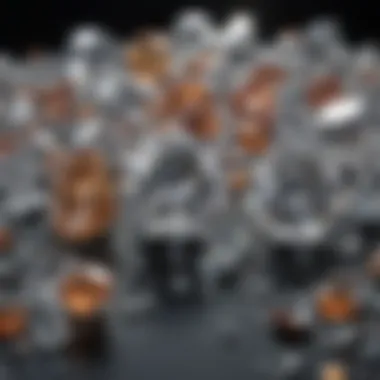
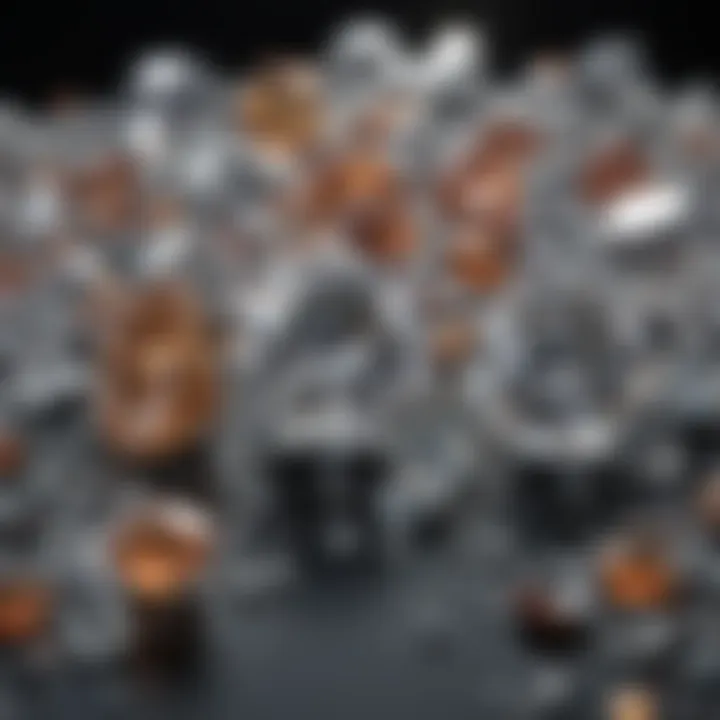
Intro
In the realm of gemstones, the dialogue surrounding lab diamonds versus natural diamonds is multifaceted. As more individuals begin to explore their options, it's crucial to understand the nuances and intricacies that define each type. This article delves into the characteristics, properties, and identification methods of both, ensuring that gemstone enthusiasts and collectors are well-equipped to navigate the diamond landscape. By shedding light on the origins, visual distinctions, and advancements in diamond technology, we aim to empower readers in their journey of selection, whether for personal enjoyment or as an investment.
Gemstone Overview
Definition of Gemstones
Gemstones are natural or synthetic materials, often mineral in composition, that are prized for their beauty, rarity, and durability. They are typically cut and polished to enhance their visual appeal, transforming raw stones into sparkling treasures fit for adornment. Diamonds, both lab-grown and natural, hold a coveted place within this category due to their exceptional hardness and brilliance.
Classification of Gemstones
Gemstones can be broadly classified into two categories: precious and semi-precious.
- Precious Gemstones: These stones include diamonds, rubies, sapphires, and emeralds. Their rarity and historical significance often elevate their value in the marketplace.
- Semi-Precious Gemstones: This category encompasses a wider variety of stones such as garnets, amethysts, and citrines. While they may not hold the same level of prestige, they possess unique beauty and charm.
Historical Significance
Origins of Gemstone Use
The use of gemstones dates back thousands of years, serving various purposes across cultures. Early societies valued gems for their supposed magical and healing properties. In ancient Egypt, turquoise and lapis lazuli were revered not just for their vibrant colors but also for their spiritual significance. Over time, gems evolved from mere trinkets to symbols of power and status.
Cultural Insights: Gemstones in Ancient Civilizations
Ancient civilizations often attributed meanings to different stones, shaping their significance within cultural contexts. For instance, in India, diamonds were believed to impart strength and courage, while in ancient Rome, they were regarded as symbols of love and invincibility. This rich tapestry of cultural beliefs showcases the depth of gemstone history beyond mere adornment.
Understanding the history and significance of gemstones enhances our appreciation of their intricate layers.
Ending
The exploration of gemology and its components serves as a roadmap for informed purchasing decisions, particularly for buyers navigating the world of diamonds. The distinctions between lab-grown and natural diamonds are not only technical but also cultural and historical. By grasping these concepts, we can cultivate a deeper respect for these remarkable stones and their stories.
Prologue to Diamond Types
When it comes to understanding diamonds, distinguishing between lab-grown and natural varieties isn't just a matter of aesthetics but also encompasses deeper aspects of value, ethics, and functionality. This section lays the groundwork for recognizing how intricate the world of diamonds is, providing a lens through which we can examine the nuances that set these two categories apart.
Not only are diamonds prized for their beauty and brilliance, but the significance of knowing their origins has far-reaching implications for buyers, sellers, and enthusiasts alike. Understanding these differences also illuminates the technological advancements that have ushered in lab diamonds, bringing a new dimension to diamond appreciation.
Understanding Lab Diamonds
Lab diamonds, sometimes called synthetic diamonds, are created through advanced technological processes that mimic the conditions under which natural diamonds form in the earth's mantle. These gems boast a composition identical to their natural counterparts, sharing the same physical and chemical properties. For enthusiasts, this opens the door to a fascinating journey into the science of gem creation.
The two primary methods for creating lab diamonds are the Chemical Vapor Deposition (CVD) and High-Pressure High-Temperature (HPHT) techniques. While both processes yield diamonds that are visually indistinguishable from natural ones, they come with distinct characteristics and implications.
What stands out about lab diamonds is not just the curious amalgamation of carbon atoms but also the environmental and ethical connotations that accompany their production. Choosing a lab diamond might appeal to those conscious of conflicts associated with traditional diamond mining.
Overview of Natural Diamonds
Natural diamonds, on the other hand, are formed over billions of years deep within the Earth's crust, under high temperature and pressure. Their journey from the depths to the surface is a tale as old as time; these gems travel through volcanic eruptions, forming in an environment that is both unique and complex.
Natural diamonds are imbued with stories of their geological formations, making each stone not just a gem but a piece of history. The imperfections found within, such as inclusions and blemishes—often termed the diamond's "fingerprint"—can also enhance their value and desirability. These features tell tales of the diamond's journey and can sometimes make them even more coveted.
It's essential to appreciate that the significance of a natural diamond goes beyond mere possession; they often carry cultural and sentimental values that resonate through generations. Understanding the divergence in formation and the ethical implications of sourcing these diamonds can empower consumers to make informed choices, whether they lean towards natural gems or the innovative lab-grown alternatives.
Formation Processes
Understanding the processes involved in the formation of diamonds is essential for anyone keen on distinguishing lab-grown diamonds from natural ones. Each type of diamond comes about through its own unique set of methods and environments that not only affect their physical attributes but also their market perception and value. Knowing the hows and whys behind these processes can help gem enthusiasts, collectors, and jewelry designers make informed decisions.
Natural Diamond Formation
Geological Conditions
Natural diamonds are formed deep within the Earth under extreme temperatures and pressures prevalent in the mantle layer. This geological setting is crucial because it allows carbon to crystallize over millions of years into the precious gems we admire today.
The key characteristic of geological conditions is the necessity of specific conditions beyond simple heat and pressure. They must include a stable environment without significant disruptions. Here’s why understanding this is a beneficial choice for our discussion: it underscores the rarity of natural diamonds, as these conditions are not universally present.
A unique feature of this process is the role of minerals and surrounding elements, which can affect the final product. For example, the presence of nitrogen can lead to yellowish hues, while boron results in blue diamonds. However, the volatility of these geological environments means that not all conditions lead to diamonds, making natural gems more precious.
Timeframes for Formation
The time it takes for natural diamonds to form can span anywhere from one to over three billion years. This extensive timeframe is what leads to the uniqueness of each diamond, effectively embedding tales of Earth’s history within every stone.
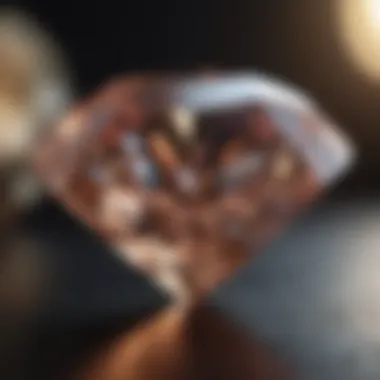
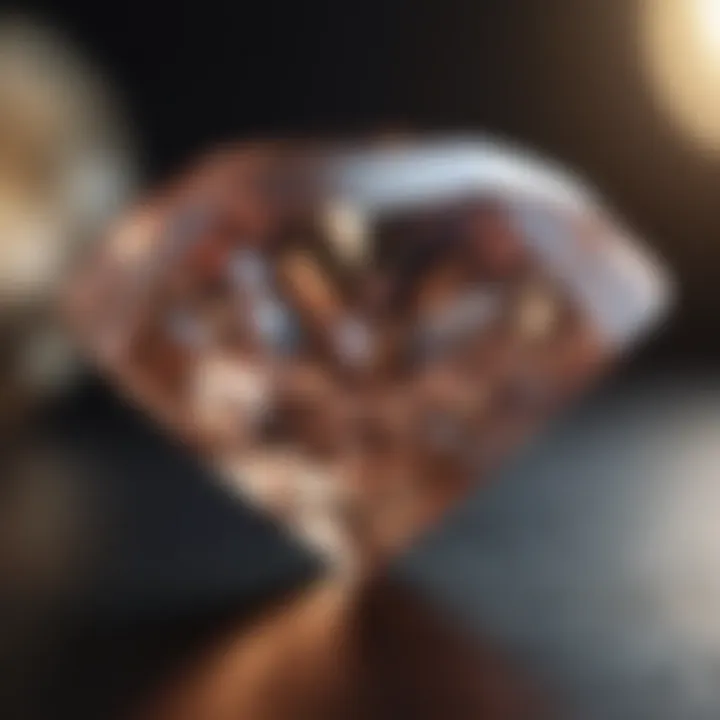
The key characteristic of this long duration is the development of what can be termed as an ‘age story’—as each diamond encapsulates a snapshot of the geological conditions over vast epochs. This long formation period brings added value as it connects the diamond not just to human culture but to the very core of the Earth itself.
While this beneficial aspect speaks volumes about the authenticity and natural origin of diamonds, it also presents disadvantages. Diamonds formed under such lengthy processes can be challenging to source, making them subject to market dynamics and availability issues.
Lab Diamond Creation Techniques
As technology has advanced, the creation of lab-grown diamonds has emerged as a viable option for consumers and jewelers alike. Understanding these techniques stands at the heart of this comparison, providing insights into the manufacturing processes that lead to these synthetic stones.
Method Explained
The Chemical Vapor Deposition (CVD) method has gained traction as a preferred lab diamond creation technique. In this process, gases rich in carbon are introduced to a vacuum chamber, where the conditions are manipulated to allow carbon to crystallize on a substrate. This method is notable for its efficiency and the high quality of diamonds produced.
A key characteristic of the CVD method is its capacity to control the diamond's growth environment precisely, making it possible to produce diamonds that can closely mimic or exceed the quality of natural ones. This tight control translates into a high degree of clarity and fewer inclusions in lab diamonds. Thus, it is a popular choice among manufacturers looking to provide consistent quality and yield.
One unique feature of the CVD process is the ability to easily harvest diamond dust, reused in the process. This attribute not only reduces waste but also renders it a more sustainable option.
HPHT Method Explained
The High Pressure High Temperature (HPHT) method closely mirrors the natural formation process of diamonds, subjecting carbon to similar extreme conditions as found deep within the Earth's mantle. This method typically crystallizes carbon using a metal catalyst, which accelerates the growth of the diamond.
The primary key characteristic of HPHT is its mimicking of natural diamond formation, which can result in diamonds that are isotopically and structurally very similar to their natural counterparts. This resemblance makes HPHT a beneficial choice for those seeking authenticity in synthetic diamonds.
However, HPHT also has unique drawbacks. The process can lead to more defects or impurities due to the intricate interplay of catalysts used during formation. Additionally, the energy-intensive nature of the method raises concerns about its environmental footprint, especially in a consumer market increasingly prioritizing sustainability.
Key Characteristics to Examine
The examination of characteristics such as visual appearance, inclusions, and overall flaws can lead to a better understanding of what you are truly buying. A keen eye for detail might spell the difference between an informed choice and a mere impulse buy.
Visual Appearance
Brilliance and Fire
Brilliance and fire are twin stars in the diamond lexicon, contributing immensely to a stone’s visual story. Brilliance refers to the white light reflected from the diamond, while fire is the scattering of light into rainbow flashes. When these factors combine, they create an enchanting spectacle that draws the eye and captures hearts.
The significance of brilliance lies in its ability to influence perceptions of quality. A diamond that sparkles brilliantly often conveys a sense of luxury and meticulous craftsmanship. Conversely, a lack of brilliance might suggest poor quality, not necessarily because the diamond is deficient, but because it might be viewed as less desirable than its more brilliant counterparts.
In terms of lab diamonds, the technology used to create them often yields stones that rival the brilliance of the finest natural diamonds. This means that, at first glance, both types can appear strikingly similar. However, the specific methods of cut and care will dramatically affect the outcome of brilliance. Ultimately, the eye-catching brilliance and fire not only enhance the aesthetic appeal but also serve as a benchmark for evaluating a diamond’s quality.
Color and Clarity
Color and clarity are two sides of the same coin when it comes to evaluating diamonds. Color refers to any visible tint, with a preference for near colorlessness in the most valued diamonds. Clarity, on the other hand, measures the presence of internal or external flaws or inclusions. Both features are fundamental to determining a diamond's quality and overall market value.
The brilliance of a diamond can be muted by color presence. Naturally occurring diamonds often possess subtle tints often considered flaws by purist standards. Lab diamonds, however, can be engineered for near-perfect colorlessness, making them appealing choices for those who desire a flawless look.
In terms of clarity, natural diamonds may showcase inclusions that tell their ancient story, while lab diamonds might appear more pristine with fewer visible imperfections. This can superficially elevate the perceived quality of lab diamonds, making them a popular choice for many when aiming for an impressive aesthetic without the premium attached to natural stones.
Inclusions and Flaws
Natural Inclusions
Natural inclusions refer to the tiny imperfections found within a diamond, usually formed during the natural crystallization process deep within the Earth. These inclusions can create unique identifiers for the diamond, much like fingerprints do for humans.
Natural inclusions highlight the diamond’s organic journey and are often favored by collectors seeking authenticity. While some may view these imperfections as flaws, others see them as character traits that give each stone its uniqueness. Each inclusion can tell a different story, making the diamond more personal for the wearer.
Yet, natural inclusions can impact a diamond's clarity grade, potentially lowering its monetary value. However, they can enhance its allure for connoisseurs who appreciate the beauty in nature's handiwork.
Lab-Specific Flaws
Lab-specific flaws arise from the synthetic creation process and can vary from bubbles and metallic inclusions to unusual growth patterns. Though they don't detract from the stone’s brilliance and often make the diamond more affordable, these flaws serve as telltale signs of the diamond's origins.
The presence of lab-specific flaws serves as a marker of authenticity, although in a different light from natural inclusions. For instance, while natural inclusions often denote a diamond’s unique history, lab flaws indicate modern manufacturing methods. This distinction can impact assessments of worth and appeal.
In sum, while lab-grown diamonds can lack the history and organic nature of natural ones, the unique features that mark lab diamonds can be appealing for different reasons altogether. These flaws offer a modern narrative to consider in the journey of diamond appreciation—providing the buyer with a new perspective on beauty.
Utilizing Gemological Tools
When it comes to identifying lab diamonds versus natural diamonds, utilizing gemological tools is akin to having a finely-tuned instrument in the hands of a skilled musician. The importance of these tools cannot be overstated; they provide clarity, precision, and a deeper understanding of the mineral wonders that we admire. By employing specialized instruments, gem enthusiasts and professionals alike can uncover the subtle distinctions and characteristics that are otherwise elusive to the naked eye.
Gemological tools play a crucial role in differentiating lab-created diamonds from their natural counterparts. These tools do not just assist in identification but also augment the overall experience of understanding gems. The benefits include:
- Enhanced Accuracy: Gemological tools can reveal specific properties that might be missed during a visual examination.
- Reliable Results: With the rigor associated with gemological testing, the likelihood of misidentification decreases.
- Educational Value: Using these tools enriches the knowledge of the person assessing the diamonds, whether they're a beginner or an expert.
Refractometer Analysis
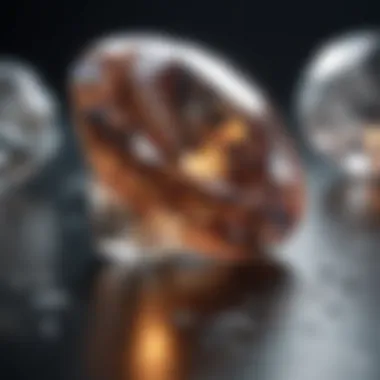
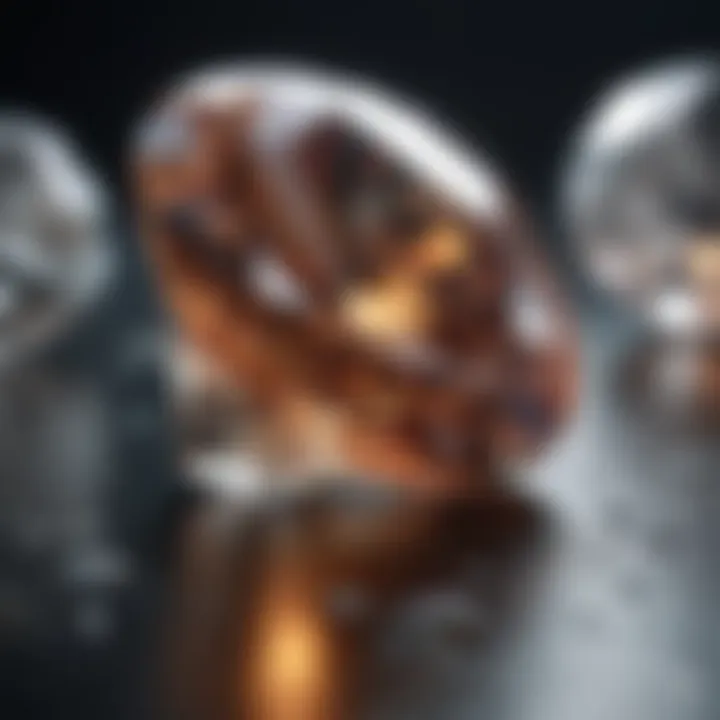
A refractometer is an essential tool in the gemologist's kit, capable of measuring how light bends as it passes through a gemstone. This analysis is particularly valuable when assessing diamonds, as it helps in determining the refractive index, which varies between natural and lab diamonds.
This instrument works based on the principle that different materials have unique refractive indices. For diamonds, the refractive index typically sits around 2.42, but lab diamonds can sometimes yield differing results because of the processes involved in their creation. The significance of this tool lies in its ability to provide quick, reliable information about the diamond being evaluated. Thus, it is instrumental in confirming if the diamond at hand fits the calculated refractive properties of a natural diamond or a lab-grown alternative.
Magnification Techniques
Magnification techniques are another important aspect when it comes to distinguishing between lab diamonds and natural diamonds. Two principal methods dominate this area: using a loupe and gaining insights through a microscope.
Using a Loupe
A loupe, while simple in design, is a powerful tool frequently employed by gemologists. It allows for detailed examination of a diamond's surface. The key characteristic here is its magnification level, which typically ranges from 10x to 20x.
This magnified view can reveal minute inclusions and surface details that tell a story about the diamond's journey. For instance, natural diamonds often contain unique inclusions created by geological processes, while lab diamonds may exhibit patterns indicative of their synthetic nature. The loupe’s portable size makes it a popular choice among gem enthusiasts visiting gem shows or retail shops. However, one must be aware that poor lighting conditions can affect the clarity of the observations.
Microscope Insights
Using a microscope goes a step further, offering even higher levels of magnification and clarity. This method is favored for its ability to delve deeper into a gemstone's structure at a microscopic level.
One significant benefit of microscope insights is the uncovering of subtle features that can help in identification. For example, natural diamonds may show growth lines from their formation, while lab diamonds may demonstrate different growth patterns. Certain high-end microscopes even allow observers to view how light interacts with the diamond's facets.
While this equipment requires more investment and is less portable than a loupe, its ability to reveal comprehensive detail makes it an invaluable asset in any serious gemologist’s toolkit. However, understanding and interpreting the results can be complex and may necessitate specific training.
"Knowledge is power, especially when it comes to distinguishing between the intricate world of diamonds. Gemological tools are not just instruments; they are windows into understanding the gems we cherish."
Testing Methods for Identification
Understanding how to accurately identify diamonds—whether they are lab-created or natural—is crucial for gemstone enthusiasts and collectors alike. The nuances involved in diamond identification stretch beyond mere visual appearances; they delve into scientific methodologies that ensure authenticity. Employing effective testing methods provides significant benefits, from confirming the diamond's origin to reflecting its market value. Knowledge of these methods can not only enhance your ability to discern between the two types but also enrich your appreciation for their unique properties.
By testing diamonds through various means, individuals ensure they’re making informed investments. Each test adds a layer of understanding, unlocking secrets that the untrained eye may overlook. This balanced approach amplifies the significance of proper identification methods in the broader context of gemology.
Heat Resistance Test
The heat resistance test serves as an intriguing first step in the identification process. While all diamonds can withstand a certain degree of temperature, lab diamonds tend to exhibit distinctive reactions when subjected to heat. This test can be executed with relative ease using a common lighter or a similar heat source. When a diamond is placed in close proximity to a flame, observe closely.
Natural diamonds can generally endure high temperatures without any visible change. In contrast, some lab-grown diamonds may display differences in their structural integrity following exposure to high heat, potentially leading to subtle color shifts or even noticeable damage. However, it’s critical to execute this test with care; excessive heat can damage any diamond.
It is vital to exercise caution; a heat resistance test can offer hints, yet it should never be the sole determinant in assessing a diamond’s origin. As a gathering of evidence, this test aids in painting a fuller picture.
UV Light Evaluation
Another fascinating avenue for identification is the evaluation under ultraviolet (UV) light. This method leverages the fact that diamonds, particularly natural ones, often demonstrate fluorescence in the presence of UV radiation. Such a reaction is less common among lab-created counterparts.
When subjected to a black light, natural diamonds might fluoresce in shades of blue, while some may show yellow or even orange hues. Lab diamonds, on the other hand, may demonstrate limited or no fluorescence at all. This discrepancy provides a distinct visual cue during evaluation.
Understanding the fluorescence characteristics can elevate your identification skills and contribute further to comprehensive assessments. Ultimately, capturing and interpreting these reactions under UV light enriches the conversation about a diamond's origins and physical attributes.
To sum up, these testing methods not only equip collectors and enthusiasts with essential tools but also enhance our overall engagement with the gem community. With careful execution of the heat resistance test and UV light evaluation, one can unravel mysteries that each diamond hides.
Professional Assessment
The accuracy of distinguishing between lab diamonds and natural diamonds has never been more critical. This section delves into professional assessment as a crucial element within the journey of identifying diamond origins.
Professional assessment incorporates systematic methodologies that are not only crucial but also elevate credibility in the marketplace. One key component is the gemological analysis, which provides reliable observations of a diamond's features, ensuring every aspect is thoroughly examined by an expert. This expertise can help buyers and sellers navigate the complex terrain of diamond valuation and authenticity, allowing for informed decisions.
Benefits of engaging a professional gemologist include:
- Trustworthiness: A trained gemologist guarantees accurate analysis, removing guesswork.
- Detailed Examination: Professionals utilize advanced tools that can reveal characteristics undetectable by the naked eye.
- Market Insights: Their understanding of market trends can guide pricing strategies tailored to the specific diamond’s characteristics.
Considerations around professional assessment often revolve around costs and accessibility. While reaching out for expertise may seem like a financial burden, the long-term value such authentication brings often outweighs the initial investment. For instance, having a lab diamond evaluated by a gemologist can bolster its market value, positioning it not just as a diamond but as a well-documented investment.
In today’s environment, where buying diamonds has become remarkably intricate, professional assessments preserve the integrity of the transaction. It's about getting what one pays for, whether it's a simple piece of jewelry or an investment asset. Investing time and resources in a professional assessment could be the make-or-break factor in differentiating a diamond that holds sentimental value from one that could ultimately contribute to an investment portfolio.
Engaging a Gemologist
When it comes to evaluating diamonds, engaging the services of a gemologist can be a game changer. Gemologists possess not only the knowledge but also the experience that shapes how diamonds are assessed. They rely on a leveraging tool, the gemstone microscope, and other empirical methods to unravel the different layers of a diamond's attributes.
Why Consider a Gemologist?
- Expert Knowledge: Their deep understanding of diamond characteristics goes beyond what is found in standard product descriptions.
- Identification Skills: They can recognize subtle differences, ensuring proper classification of lab-grown and natural diamonds.
- Certification: A gemologist can provide certificates that validate the quality and origin of the diamond, adding value to the purchase.
With numerous options available, it’s beneficial to seek a gemologist affiliated with credible organizations like the Gemological Institute of America (GIA). Establishing a connection can also build loyalty, paving the way for future assessments or professional advice.

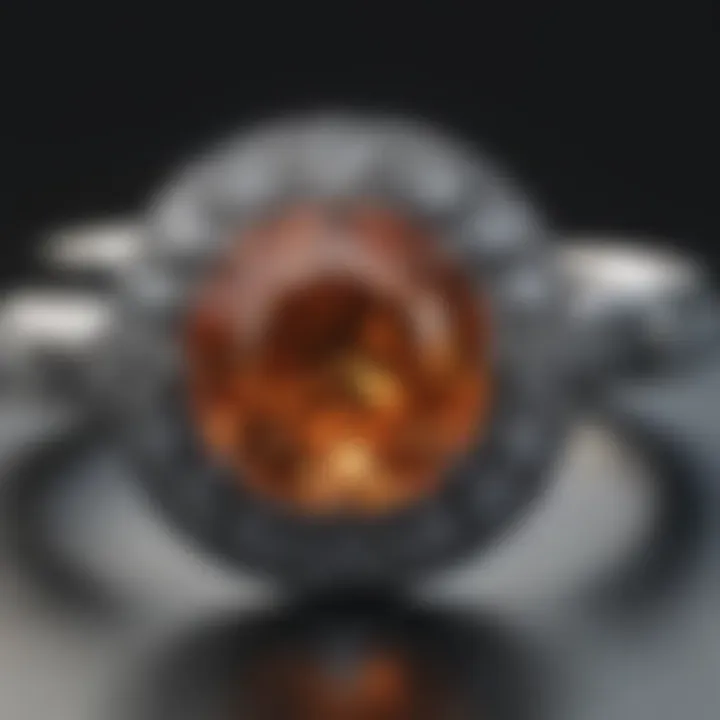
"While buying a diamond, remember: you’re not just purchasing a stone. You’re acquiring authenticity, a piece of artistry, and potentially a family heirloom."
In short, the engagement of a gemologist serves as a bridge to greater clarity and trust in an often-murky world of gemstones. The insight they provide can make all the difference in understanding not just what a diamond is, but what it’s worth and where it comes from.
Market Implications
Valuation Differences
The valuation of diamonds doesn't just rest on their beauty or rarity. It also hinges upon their origin. Lab diamonds generally come with a much lower price tag compared to their natural counterparts. This difference arises from several factors:
- Production Costs: The technological advancements in producing lab diamonds, such as the CVD and HPHT methods, allow for more efficient creation processes, thereby lowering manufacturing costs.
- Market Demand: Natural diamonds are often perceived as symbols of rarity and luxury, giving them a emotional appeal that can inflate prices.
- Resale Value: While some lab diamonds can retain value, they usually don’t appreciate in the same way natural diamonds do, primarily due to the saturated market.
In financial terms, buyers may find that lab diamonds represent a more cost-effective option. However, certain consumers still value the "natural" label, influencing resale considerations and, ultimately, price.
Consumer Perceptions
The perception of lab diamonds differs widely among consumers, affecting purchasing decisions and market dynamics. Some key elements include:
- Modern Sensibility: A growing number of buyers appreciate the innovation behind lab-grown diamonds, viewing them as a modern alternative that aligns with current ethical and environmental standards.
- Traditional Views: Conversely, traditionalists may see natural diamonds as the only true gems. For them, the allure of history and geology connected to natural diamonds cannot be replaced by technology.
- Awareness and Education: The more educated consumers are about the differences between lab and natural diamonds, the more nuanced their perceptions become. Educational resources can empower buyers, ultimately influencing their preferences.
"As knowledge spreads, so does the distinction between the two types of diamonds in consumer choice."
Ultimately, the implications of these perceptions play a significant role in shaping the trends within the diamond market, influencing everything from marketing strategies to pricing structures.
In summary, understanding both the valuation differences and consumer perceptions surrounding lab and natural diamonds offers deep insights into modern diamond markets, facilitating informed choices for all stakeholders.
Environmental Considerations
Examining the environmental considerations surrounding diamonds highlights the pressing issues of sustainability and ethical sourcing. As debates about climate change and conservation of natural resources grow more intense, it becomes essential for consumers to understand the dichotomy between lab-grown and natural diamonds. Environmental impacts extend beyond simple aesthetics—these choices can reverberate through ecosystems and local economies.
Sustainability of Lab Diamonds
Lab diamonds emerge from controlled environments, using advanced technologies. These diamonds boast several sustainability benefits that make them an appealing option for conscientious consumers. The production of lab diamonds consumes significantly less energy compared to mining natural diamonds. For instance, lab processes utilize a fraction of the water and land—important considerations in an age where resource scarcity looms. The primary benefits include:
- Reduced Ecological Footprint: Lab diamonds minimize disturbances to land and habitats. The ecological impact is drastically lower when diamonds are synthesized rather than mined from the earth.
- Less Carbon Emission: While the initial electrical input required to create synthetic diamonds can be high, the overall carbon footprint remains lesser. Additionally, many labs now utilize renewable energy sources, further decreasing environmental toll.
- Circular Economy: With lab diamonds, the option to reuse and recycle becomes viable. As the industry evolves, consumers could find second-hand lab diamonds, contributing positively to a circular economic model.
Understanding these sustainability benefits allows buyers to make choices aligning with their values while still indulging in the luxury that diamonds represent.
Impact of Natural Diamond Mining
Natural diamond mining carries far-reaching environmental consequences that often slip under the radar. Swinging the pendulum of consumer choice firmly toward lab diamonds necessitates a solid grasp of mining impacts as well. Key issues include:
- Ecosystem Destruction: Diamond mining operations routinely dismantle forests and disrupt wildlife habitats. For instance, mining practices in regions like Botswana or the Democratic Republic of Congo can have devastating effects on biodiversity.
- Water Pollution: The extraction process can lead to significant water contamination. Chemicals used in mining, such as mercury, can leach into local water sources, jeopardizing the health of communities living nearby.
- Social Implications: Many mining operations are tied to questionable labor practices. Indigenous populations may become displaced or endure unfavorable conditions as their lands are transformed into mining sites.
Ethical Implications
Understanding the ethical implications surrounding diamond sourcing is crucial for modern consumers and the jewelry industry. In recent years, the conversation about where diamonds come from has gained significant traction. Lab-grown diamonds have emerged as a viable alternative to natural diamonds, especially when considering the moral and social dilemmas tied to traditional mining practices.
Conflict Diamonds vs. Lab-Grown
A stark contrast exists between lab-grown diamonds and conflict diamonds – the latter often associated with human suffering and environmental degradation. Conflict diamonds, frequently unearthed in war-torn regions, have been linked to funding violence and promoting severe human rights abuses. These diamonds end up in markets where their origins are obscured, leading consumers to unknowingly support these degrading practices.
In contrast, lab-grown diamonds are ethically produced under controlled conditions, free from the ethical dilemmas that so often plague natural diamond mining. They are crafted using advanced technology, designed to mirror the beauty and structure of natural diamonds while ensuring that no individuals or communities suffer in the process.
It’s not just about avoiding conflict but also about embracing a cleaner, safer production method. By opting for lab-grown diamonds, buyers can enjoy gems that are not just visually stunning but also ethically sound.
To summarize, the ethical considerations surrounding diamond purchasing can significantly influence consumer choices. Increasing awareness regarding the origins of diamonds has made many consumers deliberate about their purchases. Those looking to invest their money while also standing behind a cause favorable to humanity tend to lean toward the lab-grown varieties.
"Choosing lab-grown diamonds is a step toward sustainability and ethical consumerism. Individuals can celebrate the beauty of diamonds without compromising their values."
Choosing ethical options, particularly lab-grown diamonds, can not only satisfy personal aesthetics but also support progressive practices in jewelry and gemstone sourcing. By prioritizing ethics, consumers can play a pivotal role in shaping a more responsible industry, ensuring that their choices reflect their values.
End and Recommendations
In today's market, the distinctions between lab diamonds and natural diamonds have never been more relevant. Understanding these differences is crucial for anyone looking to invest in, gift, or simply appreciate these remarkable gemstones. The complexities involved in the formation and identification of these diamonds cannot be understated, and this article has aimed to shed light on what sets them apart. Knowing the unique qualities of each type empowers consumers to make choices that align with their values, personal style, and investment goals.
Importance of the Topic
In the diamond world, consumers are confronted with a myriad of options that often lead to confusion. Recognizing the various characteristics—whether it’s the trace elements present, the way each diamond reflects light, or the ethical concerns surrounding their origin—can be the deciding factor in a purchase. Furthermore, advocates for sustainability will find solace in the advantages of lab-grown diamonds, given their reduced environmental footprint.
Summary of Key Points
- Formation Differences: Lab diamonds are created through high-tech processes like CVD and HPHT, while natural diamonds take millions of years to form deep within the Earth.
- Visual Examination: Assessing brilliance, clarity, and presence of inclusions can provide clues about a diamond's origin.
- Gemological Tools: Professional assessments utilizing refractometers and magnification can yield definitive identification of diamond types.
- Market Trends: The rising popularity of lab diamonds reflects changing consumer perceptions toward ethical purchasing and environmental responsibility.
Making an Informed Choice
When it comes to making an informed choice, it's essential to weigh all aspects discussed. Here are some considerations:
- Personal Values: If ethical sourcing is paramount for you, lab diamonds may align better with your moral compass.
- Investment Potential: Understanding that natural diamonds typically hold their value better over time might sway some collectors toward traditional options.
- Aesthetic Preferences: Regardless of origin, beauty should always be a priority; examine stones personally or consult experts.
- Budget Constraints: Lab diamonds often present a more budget-friendly alternative without sacrificing quality.



